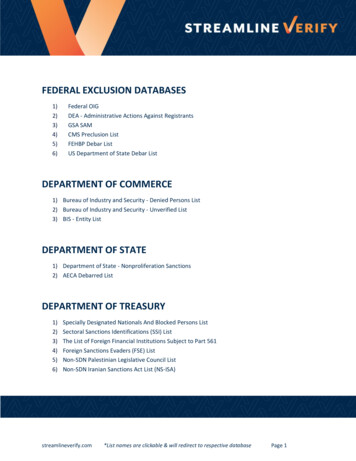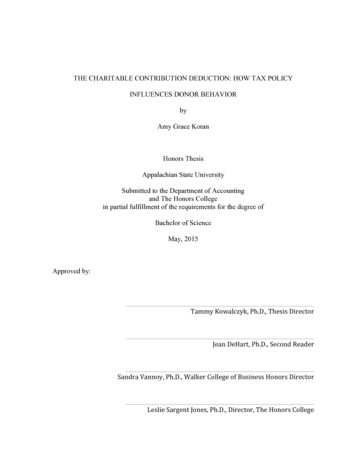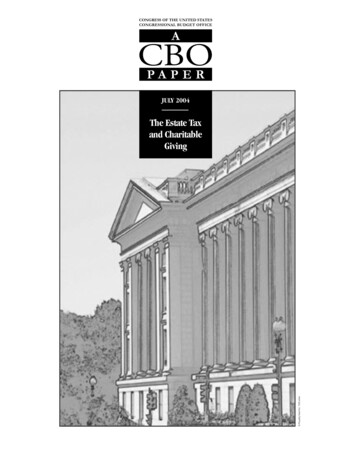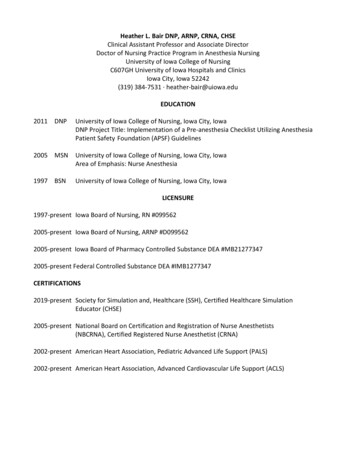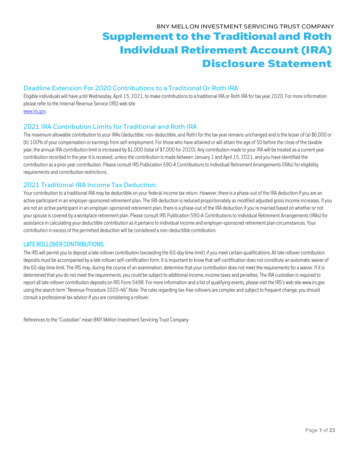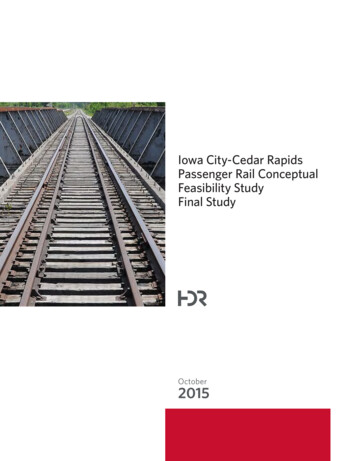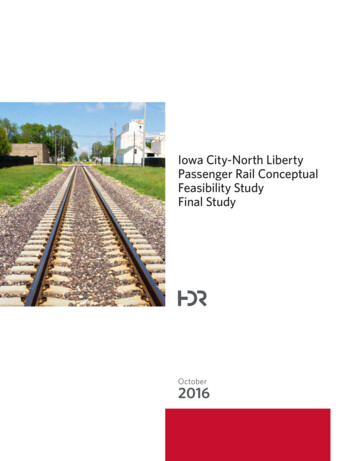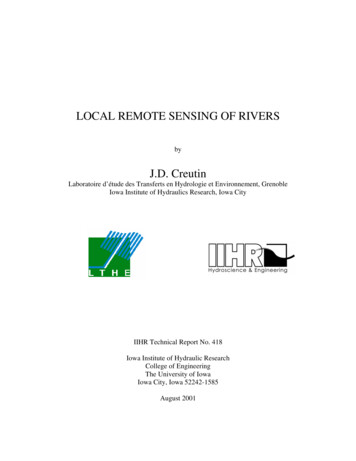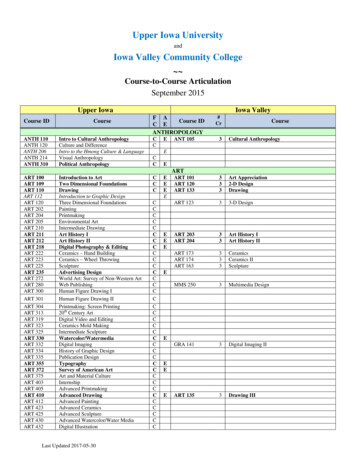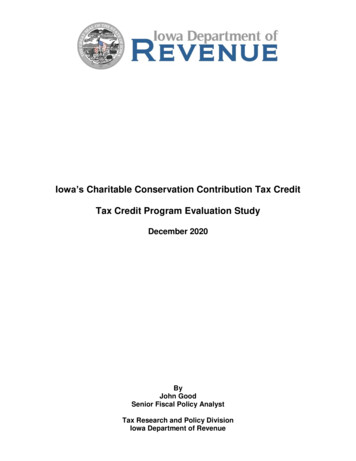
Transcription
Iowa’s Charitable Conservation Contribution Tax CreditTax Credit Program Evaluation StudyDecember 2020ByJohn GoodSenior Fiscal Policy AnalystTax Research and Policy DivisionIowa Department of Revenue
PrefaceDuring the 2005 Legislative Session the Iowa Department of Revenue received anappropriation to establish the Tax Credits Tracking and Analysis Program to track taxcredit awards and claims. In addition, the Department was directed to assist thelegislature by performing periodic economic studies of tax credit programs. This is thesecond evaluation study completed for this tax credit.As part of the evaluation, an advisory panel was convened to provide input and advice onthe study’s scope and analysis. We wish to thank the members of the panel:Biswa DasIowa State UniversityMatthew GronewaldIowa Department of Agriculture and Land StewardshipSusan KozakIowa Department of Agriculture and Land StewardshipBrent KreiderIowa State UniversityGraham McGaffinThe Nature ConservancyAnita O’GaraIowa Natural Heritage FoundationThe assistance of an advisory panel implies no responsibility on the part of its membersfor the content and conclusions of the evaluation study. This study and other evaluationsof Iowa tax credits can be found on the Tax Credits Tracking and Analysis Program webpage on the Iowa Department of Revenue website.2
Table of ContentsExecutive Summary . 5Tax Credits for Charitable Conservation Contributions across the United States . 5Charitable Conservation Contribution Tax Credit Contributions . 5Characteristics of Charitable Conservation Contribution Tax Credit Claimants . 6Charitable Conservation Contribution Tax Credit Claims . 6Analysis of Iowa Charitable Conservation Contribution Tax Credit . 7I. Introduction . 9II. Charitable Conservation Contribution Tax Credit . 9III. Tax Credits for Charitable Conservation Contributions across the UnitedStates . 12A. Federal Incentives for Conservation Contributions .12B. State Incentives for Conservation Contributions .12IV. Literature Review . 14Conservation Purpose .14Growth in Land Easements .14Unanswered Questions about the Effectiveness of Land Easements.15Distribution of Donations by Adjusted Gross Income .16Issues in Conservation Easement Tax Benefits .17V. Analysis of Charitable Conservation Contribution Tax Credit. 18A. Charitable Conservation Contribution Tax Credit Contributions .18B. Characteristics of Charitable Conservation Contribution Tax Credit Claimants .20C. Charitable Conservation Contribution Tax Credit Claims .21VI. Analysis of Iowa Charitable Conservation Contribution Tax Credit . 22A. Utilization of CCC Tax Credit .22B. State Costs and Social Benefits under the CCC Tax Credit .23VII. Conclusion . 26References . 27Tables and Figures. 28Table 1. States with Tax Credits for Charitable Contributions for ConservationPurposes.29Table 2. Charitable Conservation Contribution Tax Credit Contributions by Tax Year.31Table 3. Charitable Conservation Contribution Tax Credit Contributions by CharitableOrganization .313
Table 4. Charitable Conservation Contribution Tax Credit Contributions by Type ofContribution .32Figure 1. Charitable Conservation Contribution Tax Credit Contributed Land by Map ofIowa with County Location of Contributions, Tax Years 2008-2018 .33Table 5. Initial Earned Charitable Conservation Contribution Tax Credits by Tax Year,Tax Years 2008-2018 .34Figure 2. Distribution of Household Adjusted Gross Income for Households with CCCCredit Claimed for Tax Years 2008-2018 Compared to All TY 2018 Households FilingTaxes.35Table 6. Initial Earned Charitable Conservation Contribution Tax Credit Claimants byHousehold Adjusted Gross Income, Tax Years 2008-2018 with Comparison to All TY2018 Household Taxpayers .36Table 7. Initial Earned Charitable Conservation Contribution Tax Credit Claimants byFiling Status, Tax Years 2008-2018 with Comparison to All TY 2018 HouseholdTaxpayers .36Table 8. Initial Earned Charitable Conservation Contribution Tax Credit Claimants byAge, Tax Years 2008-2018 .37Table 9. Initial Earned Charitable Conservation Contribution Tax Credit Claimants byResidency Status, Tax Years 2008-2018 .37Table 10. Charitable Conservation Contribution Tax Credit Available and AppliedClaims by Tax Year, Tax Years 2008-2018 .38Table 11. Timing of Charitable Conservation Contribution Tax Credit Claims .39Table 12. Iowa Natural Heritage Foundation and the Nature Conservancy of IowaContribution History and Charitable Conservation Contribution Tax Credit Utilization,Tax Years 1999-2018 .40Table 13. Iowa Natural Heritage Foundation and the Nature Conservancy of IowaContribution History and Charitable Conservation Contribution Tax Credit Utilization,Tax Years 2008-2018 .40Table 14. Estimated Cost to the State of Iowa per Acre Contributed for CharitableConservation Contribution Tax Credits and the Charitable Deductions forContributions Above 200,000, Tax Years 2008-2018.41Table 15. Estimated Cost to the State of Iowa per Acre Contributed to CharitableConservation Contribution Tax Credits Against the Utilization of Only the CharitableDeduction, Tax Years 2008-2018 .41Appendix . 424
Executive SummaryThe Iowa Charitable Conservation Contribution (CCC) Tax Credit, introduced in 2008, isequal to 50 percent of the fair market value of qualifying contributed property. Charitableconservation contributions are voluntary restrictions on the use of land negotiated by alandowner and a private charitable conservation organization or government agencychosen by the landowner to hold the contribution. The voluntary restrictions on the use ofland applies to all forms of charitable contributions, whether they are bargain sales,donations, or easements.The CCC Tax Credit is automatic; any taxpayer with a qualifying charitable contributioncan claim the tax credit. The credit is nonrefundable with a 20-year carryforward and isnontransferable. The maximum amount of the tax credit is 100,000, limiting eligiblecontributions to 200,000. The amount of the contribution for which the tax credit isclaimed cannot also be an itemized deduction for charitable contributions for Iowa incometax purposes. However, if the CCC Tax Credit contribution’s fair market value is above 200,000, the excess can be claimed as an itemized deduction.The major findings of the study are as follows:Tax Credits for Charitable Conservation Contributions across the United States Although the federal government does not offer a tax credit for charitableconservation contributions, the federal conservation easement tax deduction isavailable to individuals, corporations or partnerships who contribute a charitableland conservation easement to a qualified charitable organization. Since tax year2006, an individual's deduction may not exceed 50 percent of the individual'sfederal adjusted gross income (AGI) less all other charitable contributions, butunused deductions can be carried forward 15 years. Along with Iowa, fourteen other states currently offer income tax credits forcharitable conservation contributions to charitable organizations or governmententities. All but two of the states’ tax credits are nonrefundable, meaning that thetaxpayer can only claim the tax credit in any year equal to the amount of tax liabilityowed. State tax credit rates range from 25 percent to 55 percent, with Iowa’s 50 percenttax credit rate matching five other states. Many states have taxpayer caps rangingfrom 5,000 to 500,000, with Iowa’s 100,000 falling approximately in the middleof the range.Charitable Conservation Contribution Tax Credit Contributions5
Taxpayers making CCC Tax Credit claims in tax years 2008 through 2018contributed over 15,000 acres of Iowa land, valued at over 35 million. CCC Tax Credit contributions were made to 16 different organizations. Seventysix percent of the number of contributions were made to either the Iowa NaturalHeritage Foundation or the Nature Conservancy. Contributions to countyconservation boards and other organizations accounted for 19 percent of thenumber of contributions. The remaining 5 percent did not specify the type oforganizations to which they contributed. The most popular method of conservation contribution is a conservation easementwhich accounts for 25.0 percent of the number of contributions and 35.5 percentof the total CCC Tax Credits earned. Conservation donations are the second mostused method of conservation contribution at 24.1 percent of contributions and 24.1percent of total credits earned. Bargain sales and easement bargain salescombined account for 24.8 percent of contributions and 17.1 percent of total creditsearned. The remaining contributions did not identify the manner of contributionsmade. Contributed land is reported in 50 Iowa counties. Six counties had more than 500acres of contributed land during the first 10 years of the CCC Tax Credit.Characteristics of Charitable Conservation Contribution Tax Credit Claimants In tax years 2008 through 2018, a total of 11.9 million of CCC Tax Credits wereearned for the 1,160 contributions claimed. Taxpayers who earn CCC Tax Credits tend to have higher AGI than othertaxpayers, with 72.1 percent reporting AGI above 100,000 compared to 17.9percent of all taxpayers in 2018. Taxpayers with an AGI of over 100,000 accountfor 9.4 million, or 77.4 percent, of the total earned CCC Tax Credit amounts. Over three-fourths of households with initial earned CCC Tax Credits are marriedhouseholds, including 40.1 percent filing married joint and 38.5 percent filingseparately on a combined return. Married filing joint households account for 46.7percent of the tax credit dollars initially earned and report the highest householdaverage tax credit of almost 37,000. Taxpayers 55 years or older account for nearly 68 percent, or 8.2 million, of initialearned credits. Claimants of the CCC Tax Credit above 65 years old account forabout 45 percent, or 5.5 million, of initial earned credits. Reported claimants resided in 53 different Iowa counties and outside of the stateof Iowa. Of the 377 households who have earned the CCC Tax Credit, 83.3 percentreported living in Iowa, accounting for 85.7 percent of the total tax credits.Charitable Conservation Contribution Tax Credit Claims6
Many CCC Tax Credits are not fully claimed in the year they are initially earnedand many are carried forward for multiple tax years. Between the 2008 and 2018tax years, just over 6.2 million of CCC Tax Credits were claimed out of the 11.9million of initial earned credits. Since the inception of the tax credit, an average of 59.3 percent of the initial earnedCCC Tax Credit amount has been claimed over the first five tax years observed,an average of around 78.4 percent has been claimed over the first 10 years.Taxpayers may be able to claim the remaining 21.6 percent of earned tax creditduring the 20-year carryforward period, as long as they are able to maintain apositive tax liability, however it is unlikely that all will.Analysis of Iowa Charitable Conservation Contribution Tax Credit For this study, the Iowa Natural Heritage Foundation (INHF) and the NatureConservancy (TNC) provided annual contribution counts and total donation valuesfor each year from 1999 through 2018. The data from these two organizationsindicate that since the introduction of the tax credit in 2008, their average numberof contributions increased from 16 to 25 per year. However, with multipleexogenous factors including the expansion of the federal conservation easementtax deduction effective only two years earlier, it is not possible to assign causationof the increased contributions to the Iowa CCC Tax Credit. Of the 270 total contributions reported by the INHF and TNC, only 95 contributionprojects, or 35.2 percent, used the CCC Tax Credit. Underutilization could reflectany number of reasons including unfamiliarity with the tax credit, lack of Iowaincome, lack of tax liability, the non-refundable nature of the credit, as well as therestriction against transferability. Due to the nonrefundable nature of the credit, theCCC Tax Credit is not beneficial to nonresidents or elderly residents with little tono Iowa tax liability. However, the tax credit may have incentivized some donorsto make contributions at a younger age while they have Iowa tax liability to offsetwith the nonrefundable CCC Tax Credit. When analyzing only those tax credit claims where acreage, land value, andlocation is reported, the estimated value of land contributed and claimed under theCCC Tax Credit equals 2,289 per acre. The sum of CCC Tax Credits earned andthe estimated value of the itemized deductions divided by acres contributed equals 469 per acre, or approximately 21 percent1 of the appraised fair market value ofthe land contributed2. This falls below the full 50 percent of the appraised fairmarket value of the land contributions claimed under the CCC Tax Credit in partbecause a considerable percent of contributions exceeded the 200,000 tax creditthreshold, and in part because the CCC Tax Credit, in the case of bargain sales,is only available for the difference between the appraised fair market value and theagreed upon bargain sale price. This shows that the formulation of the credit as itcurrently stands provides the state with a reduced realized impact when compared1When earned credit amount is fully claimed.Note: This specific section of the analysis focuses on the population of credit claims where full reportable data wassubmitted and made available for analysis.27
to the potential impact if claimants where able to claim a full 50 percent credit ofthe value of the contribution. Alternatively, to measure the marginal cost of the CCC Tax Credit to the GeneralFund, the reduced revenues resulting from claims were compared to the cost ofcharitable itemized deductions that would be available if the CCC Tax Credit didnot exist. The introduction of the CCC Tax Credit reduced revenues to the StateGeneral Fund by an estimated 5.9 million or 388 per acre for the sample ofcontributions where full reportable data was available. Based on this analysis thecost to the state is at most approximately one-sixth of the valuation of contributedland, well below the 50 percent tax credit amount8
I. IntroductionMany states, such as Iowa, grant tax benefits for charitable property contributions thatcomply with federal requirements. The protection of farmland, ranch land, timberland,and open space, particularly where such land is under residential or commercialdevelopment pressure and where local planning regulations identify such activities asvaluable to the community, are typical objectives of conservation contributions. Inaddition, the protection of wetlands, floodplains, important wildlife habitat, scenic views,and historic land areas and structures are also appropriate purposes for propertycontributions.The Iowa Charitable Conservation Contribution Tax Credit was first available in tax year2008. This nonrefundable tax credit, equal to 50 percent of the value of the contribution,can be claimed by individual and corporation income taxpayers who make anunconditional charitable contribution of a qualified real property interest located in thestate of Iowa to a qualified organization exclusively for conservation purposes. Charitableconservation contributions are voluntary restrictions on the use of land negotiated by alandowner and a private charitable conservation organization or government agencychosen by the landowner to hold the contribution. The voluntary restrictions on the useof land applies to all forms of charitable contributions, whether they are bargain sales,donations, or easements.Section II of the study describes the Charitable Conservation Contribution Tax Credit andhow it works. Section III provides information about similar tax credits in other states.Section IV contains a review of literature on the topic of charitable conservationcontributions. Section V presents data regarding Charitable Conservation ContributionTax Credit contributions, claimants, and claims. Section VI provides analysis of theCharitable Conservation Contribution Tax Credit and Section VII concludes this study.One aim of this analysis is to explain how the Charitable Conservation Contribution TaxCredit is administered and how the process of earning the credit is completed. Otherstates have similar conservation tax credit programs to Iowa’s and, in addition, thisanalysis will demonstrate the similarities and differences of these programs. TheCharitable Conservation Contribution Tax Credit program is separated into twoprocesses: donations and claims. This analysis will describe the donations in terms oflocation, size, and valuation. This analysis will describe claims in terms of thedemographics of the claimants as well as the value, distribution, and timing of the claimsagainst the total earned tax credit The analysis will describe the impact the CharitableConservation Contribution Tax Credit program has had on conservation donations in Iowaby demonstrating the utilization of the credit by those who are making contributionsFinally, the analysis will focus on the cost to the state for the benefit of conserved landthrough analysis of the land value of the contributions.II. Charitable Conservation Contribution Tax CreditThe Charitable Conservation Contribution (CCC) Tax Credit is equal to 50 percent of thefair market value of an unconditional charitable contribution of a qualified real property9
interest located in the state of Iowa. The maximum amount of the tax credit eligible for ataxpayer is 100,000, limiting eligible contributions to 200,000. The amount of thecontribution for which the tax credit is claimed shall not be claimed as an itemizeddeduction for charitable contributions for Iowa income tax purposes. However, if the CCCTax Credit contribution’s fair market value is above 200,000, the excess can be claimedas an itemized deduction. For example, if a taxpayer donates a qualified charitablecontribution with a fair market value of 350,000, the taxpayer can claim 100,000 as aCCC Tax Credit (50 percent of the first 200,000) and 150,000 as an itemized deductionfor Iowa. The taxpayer can claim the full value as a federal itemized deduction.Charitable Conservation Contribution Tax Credits do not require a taxpayer to apply foran award from a government organization, such as the Iowa Economic DevelopmentAuthority. Taxpayers claim the credit, if eligible, on the individual income or corporationincome tax return. In the initial tax year when the CCC Tax Credit is earned, the taxpayermust include with their Iowa tax return a copy of the Federal Form 8283, reportingnoncash charitable contributions, and any other supporting documents required to claimthe deduction on the federal return. CCC Tax Credit s are not transferrable and thereforemay not be sold or traded. For a contribution made by a pass-through entity, the tax creditmust be distributed to each owner based upon his or her share of ownership. CCC TaxCredits are nonrefundable, which means that the amount of tax credit that can be claimedin any tax year is limited to the taxpayer’s tax liability. Any tax credit in excess of the taxliability may be carried forward for up to 20 years or until the credit is claimed in full,whichever comes first.Charitable conservation contributions are voluntary restrictions on the use of landnegotiated by a landowner and a private charitable conservation organization orgovernment agency chosen by the landowner to hold the easement. A conservationeasement is a voluntary, legal agreement that permanently limits uses of the land in orderto protect its conservation values. Holding a charitable conservation easement confersthe right to enforce the restrictions imposed by the agreement. The terms of charitableconservation contributions are entirely up to the landowner and the charitableorganization to negotiate. However, the Internal Revenue Code establishes requirementsthat must be met if the contribution of property is to qualify for federal tax benefits and byextension the Iowa CCC Tax Credit. These requirements include but are not limited tocompletion of Section B of Form 8283. This form generally requires an appraisal by aqualified appraiser a statement that identifies the conservation purposes furthered by thedonation; shows the fair market value of the underlying property before and after the gift;states whether the taxpayer made the donation in order to get a permit or other approvalfrom a local or other governing authority and whether the donation was required by acontract; and, if the taxpayer or a related person has any interest in other property nearby,describes that interest.There are several types of contributions that qualify for the tax credit. The types ofcontributions that will be addressed in this study are bargain sale, conservation donation,conservation easement, and an easement bargain sale. The type of contribution can drivethe fair market value used for the calculation of the amount of the tax credit.10
A conservation easement is a legal agreement between a landowner and a conservationgroup that permanently limits the uses of the land by the current landowner and all futureowners in order to protect specified conservation values. The land remains on theproperty tax rolls with the liability remaining with the landowner. The tax credit would equal50 percent of the difference in appraised value of the land due to the easementrestrictions.Charitable conservation easements do not generally provide third parties or the publicwith the right to access or use the land subject to the agreement. However, the grantor ofthe charitable contribution may provide land for public use if he or she chooses. Unlessthe purpose of the contribution is the conservation of some feature that is meaninglesswithout public access, such as the preservation of a scenic view, no public access isrequired to qualify for tax benefits.In a conservation easement, a landowner voluntarily agrees to sell or donate certain rightsassociated with his or her property, often the right to subdivide or develop, and a privateorganization, like the Iowa Natural Heritage Foundation (INHF) or The NatureConservancy (TNC) or a public agency like the Iowa Department of Natural Resources(DNR) agrees to hold the right to enforce the landowner's promise not to exercise thoserights. In essence, the rights are forfeited and no longer exist.According to TNC, an easement selectively targets only those rights necessary to protectspecific conservation values, such as water quality or migration routes, and is individuallytailored to meet a landowner's needs. Because the land remains in private ownership,with the remainder of the rights intact, an easement property continues to provideeconomic benefits for the area in the form of jobs, economic activity and property taxes.A conservation easement is legally binding, whether the property is sold or passed on toheirs. TNC states that because use is permanently restricted, land subject to aconservation easement may be worth less on the open market than comparableunrestricted and developable parcels.A bargain sale is a sale of land or interest in land to a tax-exempt conservationorganization at a price less than the full market value. Bargain sales or land donations toconservation agencies generally help to create new public parks and wildlife areas.Depending upon the use of the land by the organization, the land may be taken off of theproperty tax rolls. In this case, the tax credit would equal 50 percent of the differencebetween the fair market value and the agreed upon bargain sale price of the land .An easement bargain sale allows a landowner to receive partial compensation as anincentive to protect land with a conservation easement. An example of this practice is ifthe receiving organization contributed a sum of money for the donor to use for legal feesor maintenance fees for the contributed land. In this case, the tax credit would equal 5011
percent of the appraised value of the land subject to the easement minus the amount ofpartial compensation from the receiving organization.Donating land for conservation is another method by which a person can make acharitable contribution. If a landowner chooses to donate their land, the selected landtrust organization can work with land owner to identify the best arrangement for the landand the landowner. The land trust organization might retain ownership of the property asa permanent preserve or transfer the property to a suitable owner, such as a governmentagency. In some cases, the land is sold to a private owner, subject to a conservationeasement held by the land trust organization. According to the land trust alliance,proceeds from such a sale could fund the land trust organization’s long-term managementof the conservation easement and/or help it to protect even more land.III. Tax Credits for Charitable Conservation Contributions across the United StatesA. Federal Incentives for Conservation ContributionsThe federal conservation easement tax deduction is available to individuals, corporations,or partnerships who contribute a charitable land conservation easement to a qualifiedcharitable organization. In general, the federal tax code limits the deductions of all typesof charitable contributions. In the case of a charitable conservation contribution, anindividual's deduction may not exceed 50 percent of the individual's adjusted grossincome (AGI) less all other charitable contributions. For corporations, the maximumamount allowable for any tax year is ten percent of the corporation's income for that year.An individual who is a qualified farmer or rancher may deduct up to 100 percent of theindividual's contribution base against federal tax liability based on federal AGI. However,if the property donated by the farmer is used for agriculture or livestock production, thecontribution must have a restriction that the land continues to be available for thatproduction. For most charitable contributions, individuals and corporations are permittedto carry forward unused charitable deductions for up to five years. For qualifiedconservation contributions, taxpayers are allowed to carry forward unused deductions for15 years.The federal deduction levels and limitations have changed over recent history. The mostrecent period of increased deduction value occurred during tax years 2006 through 2009,when the deduction limit increased from 20 to 30 percent of AGI having a 5-yearcarryforward to 50 percent of AGI with a 15-year carryforward. The additional tax benefitfor charitable conservation contributions was one of the “
The CCC Tax Credit is automatic; any taxpayer with a qualifying charitable contribution can claim the tax credit. The credit is nonrefundable with a 20-year carryforward and is nontransferable. The maximum amount of the tax credit is 100,000, limiting eligible contributions to 200,000. The amount of the contribution for which the tax credit is
